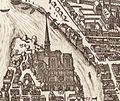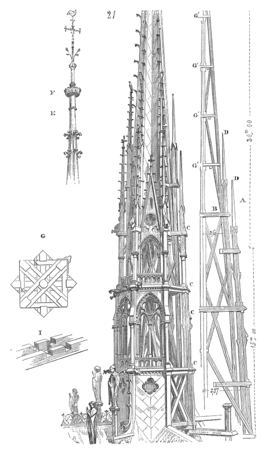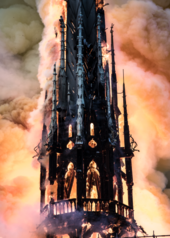Notre-Dame de Paris crossing tower

The crossing tower of Notre-Dame de Paris ( French la Flèche ) was - next to the two towers of the west facade - the third and until 2019 tallest tower of the Notre-Dame de Paris cathedral . A first crossing tower was built around 1230. It partially collapsed in the mid-18th century and was completely dismantled thirty years later. The roof turret, built in 1859 under the planning and direction of the architect and art historian Eugène Viollet-le-Duc , broke on the evening of April 15, 2019 during the fire of Notre-Dame in Paristogether. Two days later, the French Prime Minister Édouard Philippe announced an international architectural competition for the crossing tower.
First crossing tower (13th to 18th centuries)
The original crossing tower was erected over the crossing of the cathedral in the 13th century, probably between 1220 and 1230 . Even this tower had a cleverly constructed frame that distributed the weight of the tower evenly over the pillars of the crossing. It was designed as a bell tower and carried six bells plus a wooden bell. In the long run it was unable to cope with the wind pressure and partially collapsed in the middle of the 18th century. It was completely dismantled between 1786 and 1792.
- Medieval crossing tower
The entry of Elisabeth of Bavaria into Paris, miniature in Froissart's chronicles, which are attributed to Philipp von Mazerolles (around 1470–1472)
The cathedral in the Roman Pontificale by Jean de Mauléon, Bishop of Comminges (around 1525–1530)
The cathedral on the map by Claes Janszoon Visscher (1618)
View of the Île de la Cité with the cathedral by Nicolas Raguenet (1752)
Viollet-le-Duc crossing tower (1859-2019)
Notre-Dame without crossing tower, photograph by Édouard Baldus , 1850s
View over the nave to the crossing tower, after 1860, photograph by Charles Marville
construction
The cathedral remained without a crossing tower for decades. During the restoration work carried out by the architects Jean-Baptiste Antoine Lassus and Eugène Viollet-le-Duc , a neo-Gothic crossing tower was built. The new crossing tower looked like a roof turret due to its slim shape and was modeled on the crossing tower of Orléans Cathedral , which was built from 1855 to 1859 . With a height of 96 meters, however, it lagged well behind the tower in Orléans, which reached 114 meters. Its scaffolding was erected by Auguste Ballu's joinery, who also built the tower in Orléans. The Paris tower consisted of 500 tons of lead-clad oak beams from Champagne and was covered with 250 tons of lead . The octagonal frame on the upper base - above the crossing vault - had an edge length of seven meters and rested on the pillars of the crossing, although it was not structurally connected to the roof structure. The tower had two accessible platforms above which the tower spire loomed. Inside the tower was a belfry with three bells, but it was not primarily designed as a bell tower. The tower was inaugurated on August 15, 1859, the day of the Cathedral's patronage, " Assumption of the Virgin Mary ".
- Plans after Eugène Viollet-le-Duc
Design and image program
The crossing tower had a rich figural and ornamental decoration made of metal, the weight of which was estimated at over 200 tons. Between the corners formed by the main nave, transepts and choir, four buttresses leading downwards were attached, each supporting pedestals with three copper statues of the apostles made by the sculptor Adolphe-Victor Geoffroy-Dechaume . An iconographic saint attribute is added to each of the apostles . Eleven of the apostles overlooked the city of Paris. Only the figure of the unbelieving apostle Thomas ( Joh 20,19-29 EU ) turned around and seemed to examine the construction of the tower in a thoughtful and doubtful pose. The facial features of the figure of the patron saint of carpenters , builders and architects are based on those of the architect Viollet-le-Duc. A fourth lower pedestal each carried a figurative representation of a winged bull , a winged lion , an eagle and a winged human . The four creatures come from the God's vision of the prophet Ezekiel and make the four worshipers before the throne of God ( Ezek 1.4 to 28 EU represents), which is also the author of the New Testament apocalypse were taken ( Rev 4,6-8 EU ). According to the testimony of the Bible, they proclaim the holiness of God. All four beings each carry a book. With their bodies turned toward the city, their faces looked up at the cross at the top of the tower. In Christian theology and iconography the four heavenly beings are associated with the four evangelists John , Luke , Mark and Matthew . The human-faced being stands for the incarnation of Jesus, the bull-faced being for his sacrificial death, the lion-faced being for the resurrection and the eagle-faced being for Jesus' return to the Father. All sixteen copper figures stood on a plinth of clouds .
The crossing tower was surrounded by four wreaths of mythical creatures as mythological guardian figures . The lower gallery was formed from two-lane Gothic windows with a crowning quadruple . The arches were each set with 21 rose buds, which as a symbol of the " Rosa mystica " ( Latin for "mysterious rose") referred to the patroness of the cathedral, who is invoked as such in the Lauretanian litany . The upper gallery opened in single-lane windows with set “noses” in the form of a so-called nun's head . Between the two galleries, a wreath of intertwined iron branches of thorns was drawn around the tower, symbolizing Christ's crown of thorns, which is kept as a relic in the cathedral . On April 10, 1239, the French King Louis IX. handed over to the cathedral the crown of thorns of Christ, which was later transferred to the Sainte-Chapelle . The relic has been back in Notre Dame de Paris since the 19th century. The eyelashes rising above the upper gallery of the crossing tower were each decorated with two three-pass, one four-pass and a concluding lancet window. Wreaths of pinnacles rose on two levels between the eyelashes . The octagonal top was adorned with twelve crab wreaths one on top of the other .
The top of the tower was formed by a Marian crown ring made of roses and lilies, above which a six meter high cross with a copper cock at the top rose. The ring of roses can be interpreted as a reference to the rosary prayer , the lily wreath usually stands as a symbol of the everlasting virginity of Mary . The tower cock is a reliquary containing three relics: a piece of the crown of thorns , the halves of which are in the Vatican and in the Notre-Dame de Paris cathedral, as well as a relic each of the two Paris patrons, Dionysius and Genoveva . While the messenger of faith and first bishop of Paris, Dionysius, is said to have been martyred in Paris in the 3rd century , Genoveva saved the city in the 5th century, according to legend, through her prayer from the attacking Huns under their king Attila . In addition, it also aims to conversion of the previously pagan Frankish king I. Clovis contributed. The piece of the crown of thorns was placed in the reliquary by Viollet-le-Duc himself in 1860. The rooster was restored in 1935, the mandrel was replaced by the Parisian Archbishop Jean Verdier .
Three statues of the apostles and the bull symbolizing the evangelist Luke
Detail of the statue of the Apostle Thomas , with the facial features of Eugène Viollet-le-Duc .
As a building of great symbolic importance for the French nation, the Notre-Dame de Paris Cathedral and its crossing tower have repeatedly been the target of political and artistic activity. The French writer and traveler Sylvain Tesson climbed the towers of numerous churches in the 1990s and spent entire nights there. He has also climbed the crossing tower of Notre Dame repeatedly, a hundred times by his own account. On March 10, 1997, the French mountaineer Chantal Mauduit unfolded a flag of Tibet on the tower to commemorate the 1959 uprising in Tibet . Two years later, the tower was occupied by political activists for the same reason.
Destruction 2019
On April 15, 2019 around 6:50 p.m., a fire broke out in the roof area of Notre Dame de Paris . The fire spread quickly due to the high fire load of the 13th century roof beams and also hit the crossing tower. The lead cladding of the beams did not provide adequate protection from the effects of the flames, so that the tower was also in a full fire in a short time. At 7:45 p.m., the upper part of the tower helmet buckled and pierced a yoke of the longship. The lower part of the tower, which continued to burn, later also collapsed and caused the vault to collapse over the crossing .
The sixteen copper statues attached below the crossing tower had been removed a few days before the fire and brought for restoration. The copper cock attached to the top of the tower fell through the vault into the nave with the rubble of the crossing tower. It was salvaged and also brought for restoration, which was planned for June 2019 before the fire. Nothing is known about the condition of the relics.
Rebuild plans
On April 17, 2019, the French Prime Minister Edouard Philippe announced an international architectural competition to rebuild the crossing tower. Philippe put forward the thesis that the Paris cathedral did not have a crossing tower before the 19th century and that Eugène Viollet-le-Duc added it on his own initiative. Philippe asked whether and how the tower should be rebuilt. Philippe named an identical reconstruction based on the design by Viollet-le-Duc or the realization of a modern design that corresponds to the current state of the art and today's needs ( French d'une nouvelle flèche adaptée aux techniques et enjeux de notre époque ). The French Senate voted in favor of a reconstruction based on the Viollet-le-Duc design.
literature
- Claude Gauvard: Notre-Dame de Paris, Munich 2019, ISBN 978-3-8094-4176-2 .
Web links
- Ullrich Fichtner: Our Lady . In: Der Spiegel . No. 17 , 2019, pp. 108-113 ( online ).
- La flèche , website of the Notre-Dame de Paris cathedral , with numerous photos
- Le spectaculaire déplacement des statues de Notre-Dame pour leur restauration , Le Figaro website, with photos of the dismantling of the statues a few days before the fire
- Vidéo - Incendie à Notre-Dame: les images de la flèche en train de s'effondrer , website of La Chaîne Info , video of the collapsing crossing tower
Individual evidence
- ↑ Ullrich Fichtner: Our all woman . In: Der Spiegel . No. 17 , 2019, pp. 108–113 ( online - here p. 113).
- ↑ a b c Ch. Friès: Notre Dame de Paris (Travaux de restauration) . In: Encyclopédie d'architecture 1859, Volume 9, No. 7, Column 109–112, digitized version .
- ↑ a b La flèche , Notre-Dame de Paris Cathedral website , accessed on April 17, 2019.
- ↑ Cindy Roudier-Valaud: La flèche de Notre-Dame de Paris était inspirée de celle de la cathédrale d'Orléans, et bâtie par le même charpentier , La République du Center , April 16, 2019, accessed on April 17, 2019.
- ^ Edmond Renaudin: Paris Exposition, ou guide à Paris en 1867 . Delagrave, Paris 1867, pp. 94-95, digitized .
- ↑ Lemma Flèche . In: Viollet-le-Duc : Dictionnaire raisonné de l'architecture française du XIe au XVIe siècle, tome cinquième . A. Morel, Paris 1875, pp. 426–472, here pp. 446–461, digitized .
- ↑ Flèche de Notre Dame de Paris . In: Encyclopédie d'architecture 1860, Volume 10, No. 2, Column 26, digitized .
- ↑ Géza Jászai: Evangelist or God's symbols ?, On the iconology of the Maiestas Domini representation of the Carolingian Vivian Bible, in: Das Münster, Zeitschrift für Christian Kunst und Kunstwissenschaft, 1, 2019, 72nd year, Regensburg 2019, p 25-29.
- ↑ Notre Dame - Les toits - Les apôtres , NDParis Free website, accessed on April 18, 2019.
- ^ Margot Schmidt, Silke Egbers: Article "Rose". In: Marienlexikon , ed. on behalf of the Institutum Marianum Regensburg eV by Remigius Bäumer and Leo Scheffczyk, Volume 5, St. Ottilien 1993, pp. 548-552.
- ↑ Lottlisa Behling: The flora of the medieval cathedrals. Vienna 1964.
- ↑ Gerd Heinz-Mohr, Volker Sommer: The Rose. Unfolding of a symbol. Düsseldorf / Cologne 1991.
- ↑ Waltraud Hahn: Article "Paris", Marienlexikon. ed. on behalf of the Institutum Marianum Regensburg eV by Remigius Bäumer and Leo Scheffczyk, Volume 5, St. Ottilien 1993, pp. 91-96.
- ↑ Genoveva Nitz: Article “Crowning of Thorns”. In: Lexicon for Theology and Church. Volume 3, special edition as revised edition of the 3rd edition 1993–2001, Freiburg / Basel / Vienna 2009, Sp. 345–346.
- ↑ Andreas Heinz, Doris Gerstl, Konstantinos Nikolakopoulos, Michael Hartmann, Hans Pörnbacher, Horst Rzepkowski: Article "Rosenkranz". In: Marienlexikon. ed. on behalf of the Institutum Marianum Regensburg eV by Remigius Bäumer and Leo Scheffczyk, Volume 5, St. Ottilien 1993, pp. 553-559.
- ^ Margot Schmidt, Silke Egbers: Article "Rose". In: Marienlexikon. ed. on behalf of the Institutum Marianum Regensburg eV by Remigius Bäumer and Leo Scheffczyk, Volume 5, St. Ottilien 1993, pp. 548-552.
- ↑ Josef Scharbert, Genoveva Nitz: Article "Lily". In: Marienlexikon. ed. on behalf of the Institutum Marianum Regensburg eV by Remigius Bäumer and Leo Scheffczyk, Volume 4, St. Ottilien 1992, pp. 121-122.
- ↑ Waltraud Hahn: Article "Paris", Marienlexikon. ed. on behalf of the Institutum Marianum Regensburg eV by Remigius Bäumer and Leo Scheffczyk, Volume 5, St. Ottilien 1993, pp. 91-96.
- ↑ Thomas Hermans: Notre-Dame de Paris: la sidération et l'émotion de Jack Lang, Fabrice Luchini, Marion Cotillard ... , Le Figaro , April 16, 2019, accessed on April 18, 2019.
- ↑ Notre-Dame du Tibet , Liberation , March 11, 1999, accessed April 18, 2019.
- ↑ Vidéo - Incendie à Notre-Dame: les images de la flèche en train de s'effondrer , La Chaîne Info website , April 15, 2019, accessed on April 18, 2019.
- ↑ Thomas Hermans: Le spectaculaire déplacement des statues de Notre-Dame pour leur restauration , Le Figaro , April 12, 2019, accessed on April 18, 2019.
- ↑ Claire Bommelaer and Jean-Baptiste Garat: Notre-Dame: le coq de la flèche retrouvé parmi les décombres , Le Figaro , April 16, 2019, accessed on April 18, 2019.
- ^ Notre-Dame: un concours international d'architecture pour reconstruire la flèche . In: Le Figaro . April 17, 2019, accessed April 17, 2019.
- ↑ Reconstruction of Notre-Dame: Cathedral should look like it did before the fire . In: Deutschlandfunk . May 28, 2019, accessed June 2, 2019.
Coordinates: 48 ° 51 '10.6 " N , 2 ° 21' 0.3" E



















